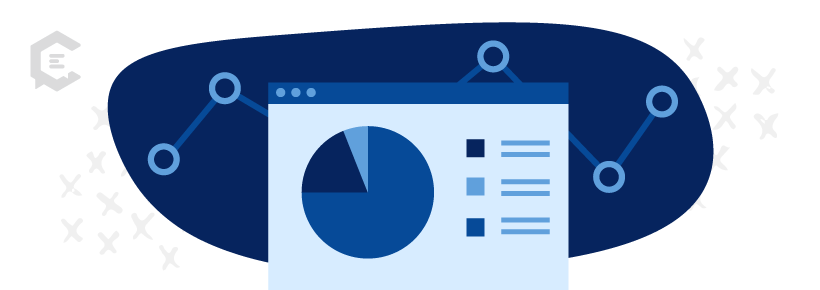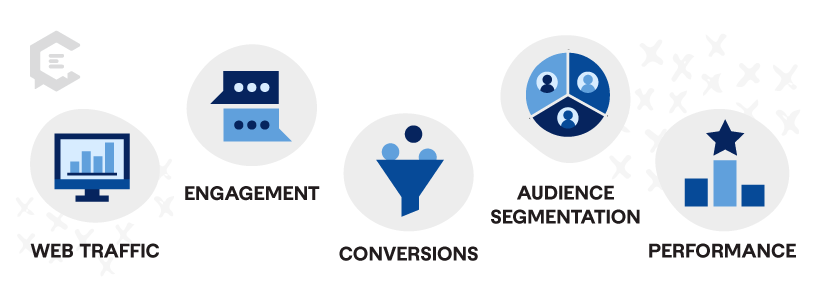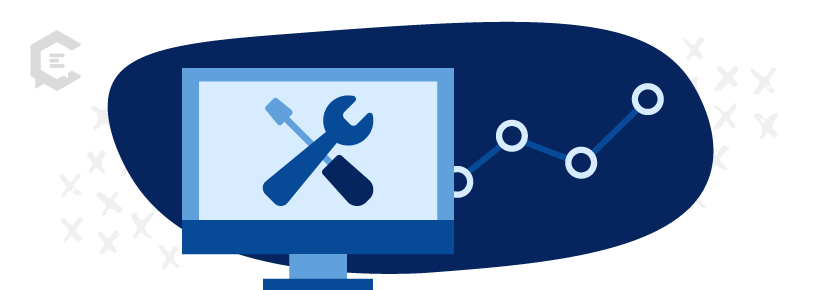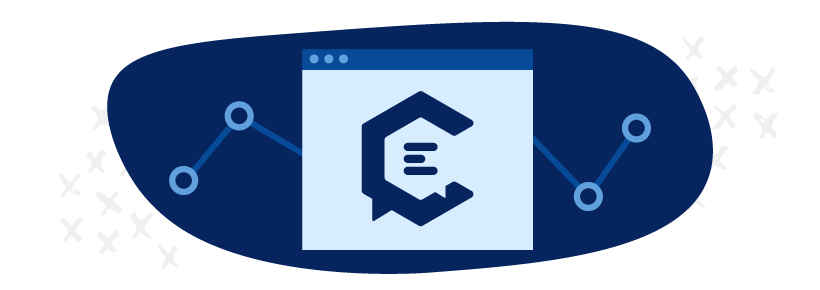What are web analytics?
Web analytics refers to the process of collecting, measuring, and interpreting the data of your audience’s behavior and how they interact with your content.
By tracking various metrics and key performance indicators (KPIs), we can gain statistically supported insight into the effectiveness of our marketing efforts. Web analytics can include data points about website traffic, audience demographics, user engagement, conversion rates, and other relevant information.

Why are web analytics so important?
Launching a website is an arduous task worth celebrating. However, all that work can be squandered if you don’t have a strong web analytics program to help you understand your audience. Analyzing user behavior allows us to create targeted, personalized content that resonates with our audience. We can also see which content is performing, what strategies are effective, and where we can improve.
What are the key aspects of web analytics?
- Web Traffic: Web analytics tools provide information about the number of visitors, where they came from (organic search, social media, referrals, etc.), and their behavior while on the site.
- Engagement: These tools can track the time spent on a page, how deep they scroll, and their click-through rates. This data can show how your content resonates with your audience by measuring how much they engage with it.
- Conversions: Your content may be interesting, but is it actually generating new business? Conversion tools can track specific actions such as form submissions, newsletter sign-ups, or purchases.
- Audience segmentation: These web analytics tools can separate your audience into various criteria like demographics, location, device type, or referral source. Breaking your audience into specific groups can help personalize your strategy for each user.
- Performance: It’s a tough pill to swallow, but your favorite piece of content may not be the one that performs the best. Web analytics can track the performance of individual content assets, monitoring metrics such as page views, engagement, and conversions. This way, we can assess our efforts’ effectiveness without being influenced by personal bias.
What are the best web analytics tools on the market today?
Several excellent web analytics tools are available today that cater to different needs and budgets.
Google Analytics:
Google Analytics is one of the most popular and widely used web analytics tools because of its seamless integrations into the vast suite of Google products. Who hasn’t heard of Google? Am I right? Google is a tech giant that includes everything a content marketer needs while having the extreme advantage of owning major content aggregating platforms like YouTube and, oh yeah, the front page of Google. While the depth of Google’s data analysis is vast and has free options, it’s important to note that all the user information you gather is being shared with Google itself.
Adobe Analytics:
Adobe Analytics (AA) provides in-depth insights into customer behavior, segmentation, and personalization options. It capitalizes on its creative design roots by transforming the data into easy-to-understand flow charts. Adobe leads the pack in visualizing path analysis, allowing you to point and click touchpoints in your user’s journey giving you clear insight into what your audience is doing before and after each interaction with your content.
Matomo (formerly Piwik):
Matomo is an open-source web analytics platform focusing heavily on privacy features. While tools like Google Analytics transform user data into products, Matamo offers self-hosting options for enhanced data privacy and control. Matomo also offers media analytics, allowing you to go in-depth on how many plays your media gets, finish rates, how your media is consumed over time, on specific days, or even in which locations users view your content.
Hotjar:
Hotjar goes beyond the numbers and offers unique web analysis tools such as heatmaps and session recordings, allowing you to watch how users interact with your site in real-time. They also provide 1-to-1 interviews with your users, making it the most personable of our listed analytics companies.
Some real-world examples
Now that you have all this data about your audience, how do you use it ethically and effectively? Your web analysis tools may provide demographic data about your consumers, including age, gender, location, or interests.
For instance, if you discover that a significant portion of your audience is located in a specific region, it may be valuable to learn their language idiosyncrasies. Some of us say soda, some say pop, and others call everything Coke. These differences matter to people. You may also be designing a website with some glitch-style fonts for Gen Z you think is “fire,” only to find out the majority of your consumers are millennials. Every piece of data helps you better understand your target audience and create content that is appealing to them.
Working in Social Analytics
Social media platforms have their own set of social analytics programs, which are a must when building your marketing strategy. Social analytics tools keep your ear to the ground for monitoring:
- Brand Mentions
- Customer feedback
- Sentiment analysis (also known as opinion mining)
- Identifying trends
Built-in social analytics programs like Facebook Analytics offer extensive details regarding audience demographics. Its users offer up their own identifying features like hobbies, favorite movies, books they love, and a catalog of events they are interested in or have attended.
Social analytics tools are also one of the best ways to monitor your competitors. These tools can identify your competition’s successful strategies, content types, and engagement tactics so you can learn from them and adjust accordingly.
Web analytics: More than building a website
Web analytics fosters a culture of continuous improvement. By regularly monitoring and analyzing data, we can identify trends, spot opportunities, and make evidence-based adjustments to content strategies. This ever-evolving approach leads to ongoing optimization and better results over time.
Get high-quality, SEO-friendly copy for your website today by talking to a content specialist at ClearVoice.






